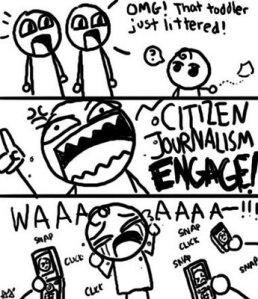Did you see the Facebook photos of the protest in Egypt years ago? Did you find out the breaking news about the missing airplane in Malaysia through Twitter? Or have you been tweeting about newsworthy events which you are physically present when it happened? If yes, welcome to the new age of citizen journalism. 
What is Citizen Journalism? According to Dave Ross of How Stuff works, “it is any type of news gathering and reporting — writing and publishing articles about a newsworthy topic, or posting photographs or video of a newsworthy event that is done by members of the general public rather than the professional news agencies commonly referred to as “mainstream media.” Citizen journalism is an active participatory reporting of the public about different things, such as accidents and crisis, which happen around us.
Through citizen journalism, people could share their point of view of the story – which in this case people from the different sides of the world could clearly get important information and see what is happening. Citizen journalism is also a great tool for the public to know the different perspectives of the news as well as citizen journalists will definite have the first hand information.
With the vast advances in technology – such as the internet, social media and inventions of smartphones and tablets, citizen journalism becomes more prominent. Social media has been the major platform for citizen journalism, especially for the breaking news stories. Since millions of people are using the social networking sites, news could spread in just a click away. We could say that Facebook and Twitter are the major news sources when it comes from citizen journalism.
Twitter has been a very good tool for the new age of journalism – within 140 characters, people could tell important information or news about an event. With the use of ‘Hashtag’ or pound symbol – “#” – and/or common words to describe the event, news could spread in all the side of the world in a snap; being on the trending topic lists also help for people to recognize the news. In Facebook on the other hand, news could spread quickly through posts (with hastags), likes and as well as in comments.
Photos of the actual events could also quickly spread on Facebook by sharing it. Photography in citizen journalism – is very beneficial especially on Facebook, for it shows more to the users on what is “presently” happening. A best example to explain the importance of photos in citizen journalism was the Arab Spring Revolution – where in all the professional media broadcasting news were banned in disseminating information and updates, thus the citizens of the nation tried to use social network sites to pass to the world the actual and “real time” events. With that, Facebook revolution began where people went to the streets to voice out their retributions with their government.
Social media is indeed a very powerful tool in showing the voice of the public; it helps the people to be aware of their surroundings. As David Wolman of Wired Magazine said to his article Facebook, Twitter Help the Arab Spring Blossom “Social networks don’t overthrow governments—people do, courageous people who, despite the risk of retribution or even death, take to the streets because they have had enough.”
Social media platform and other technological advances indeed have greatly affected the way news gathering and dissemination across the world. With the use of these tools, we still need to be responsible and aware of all the information the we get from the World Wide Web.

